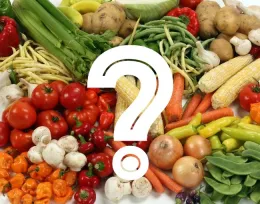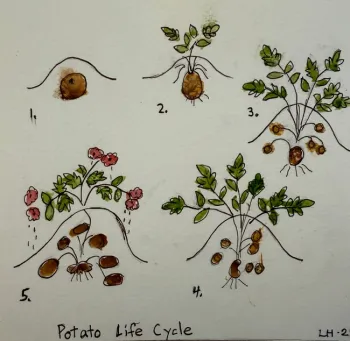Can you guess which plant:

- Was first grown in the Peruvian Highlands between eight thousand and five thousand years BC
- Was poisonous if not eaten with clay until modified varieties were propagated
- Is now the fifth most important food crop in the world
- Produces asexually, creating endless clones, like science fiction
- Can be brown, red, yellow, or purple, but is poisonous if green
- Brought Europe food security for centuries, but also created a famine in Ireland
- Caused two million Irish to immigrate to the USA
- Is the first crop to bring on modern industrial agriculture by introducing the first fertilizers and pesticides
The answer, of course, is the lowly potato. How can the potato be in the center of so much history?
As unlikely as it seems, potatoes were first grown in the Peruvian Highlands where few crops grow, and fueled the Inca Empire, which propagated and consumed over 150 species. Even more unlikely: the plant came from deadly nightshade vines which were initially poisonous if not consumed with clay, an innovation first discovered by grazing llamas and copied by the Incas.
As an important part of the Columbian Exchange, potatoes were introduced to Europe, first in the Canary Islands, by Spanish Conquistadors who brought them back from Peru in 1536. Over about forty years, the plant swept the European continent and was introduced to Ireland by Sir Walter Raleigh in 1589, where they became such an important staple that people wonder what the Irish ate before them. More reliable than wheat, two new world crops: potatoes in Northern Europe and corn in Southern Europe, drastically increased European calorie intake and reduced famines from 1750-1950. They were also the first crop to be actively fertilized, by guano, also imported from Peru, predicting the modern fertilizer industry.
From 1845-1851, Ireland suffered a terrible famine caused by Phytophthora infestans, a water mold which destroyed the staple potato crop and caused the death of over a million Irish people. Two million Irish immigrated, mostly to the United States, creating a reverse Columbian Exchange. Another potato pest, the Colorado Potato Beetle, initiated the creation of the first artificial pesticide, a form of arsenic, which resulted in endless experimentation with improved pesticides and launched the modern pesticide industry. Fertilizers and pesticides, which were both first used on potatoes, defined the Green Revolution, from 1940-1950, which transformed agriculture worldwide, and is now highly controversial.
February is the month to plant potatoes in Yolo County
In addition to having a colorful history, potatoes are a very satisfying home garden crop to grow. Because the Andean potato likes cold climates, such as Peru and Ireland, it must be planted early in the Central Valley. This makes potatoes a good crop to grow and harvest before many others.
Potatoes are not generally grown from seed, but rather from “seed potatoes” which are not really seeds, they are arrested tubers sold for planting. While potatoes can be grown from old ones which sprout in your cupboard, purchased seed potatoes are safer producers. Regular potatoes have usually been treated with growth retardant. Some local nurseries carry seed potatoes in February. They can also be mail ordered and are now available in many varieties. Once you get them, seed potatoes should be cut in pieces, with one to two eyes per piece, and dried for a day or two before planting.

When potatoes make flowers, “new” potatoes with thin skins and a delicious, delicate flavor can be dug. When the potato plant has bloomed and is dying, larger, thicker skinned mature potatoes are ready. Potatoes can be harvested either or both ways, between about sixty and ninety days from planting. A word of caution: if potatoes are not covered by dirt as they grow, they can become green. Green potatoes contain the chemical solanine, which is toxic, and should not be eaten.
People wonder whether potatoes are the cousins of sweet potatoes. The answer is “no.” Sweet potatoes grow on swollen roots, not stems, and are members of the morning glory family. Potatoes, on the other hand, are in the nightshade family, along with tobacco, tomatoes, peppers, and eggplants.
To me, potatoes are an altogether satisfying garden plant. Digging them is a treasure hunt, fun for children and for the child in all of us. They grow at a time of year, February/March to May/June, when other spring crops cannot be planted. They are hearty, easy to grow, and pretty. And above all, the superiority of a home-grown fresh potato in comparison to a store-bought one rivals that of home-grown sweet corn or tomatoes. Thomas Jefferson was so taken by the French fries he consumed in France that he re-introduced potatoes to North America by serving them in the White House, thus reversing the Columbian Exchange and starting a potato craze in the United States that has never waned.
Post Script: If you have space in your garden, February is also a great time to plant a second crop of winter vegetables--- the cole family (cauliflower, broccoli, Brussels sprouts, kale, kohlrabi, and cabbage), peas, lettuces, greens, carrots, and beets— for a late spring harvest.
References:
The California Master Gardener Handbook, Second Edition (2022).
Mann, Charles C. 1493: Uncovering the New Worlds Columbus Created. 2011.
This article was originally published in The Yolo Gardener Newsletter, February 2025

